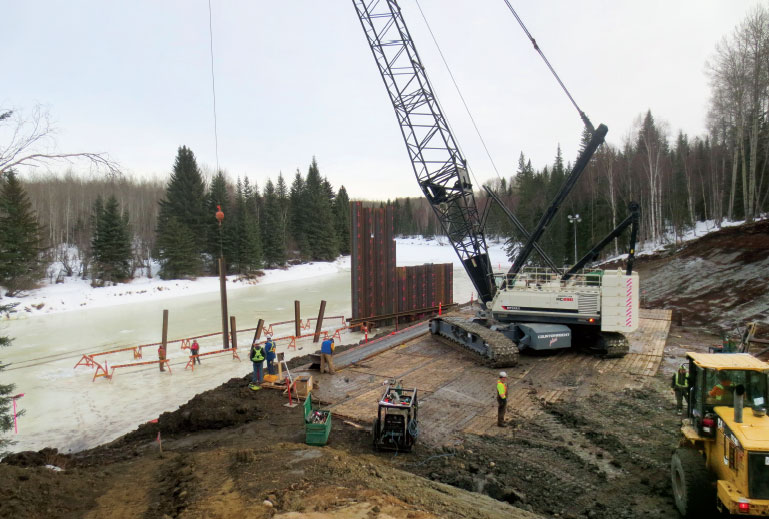
Building a water intake structure on a remote Alberta river during winter provided some interesting challenges for construction crews from Formula Contractors Ltd.
Deep foundation work, when it’s done in isolated northern locations in the deepest cold of harsh Canadian winters, can be an ordeal. Sometimes, though, it can be even more challenging when the weather isn’t cold enough. That was the case for the Little Smokey River Water Intake Project near Fox Lake, Alta.
The project, which involved the construction of a sheet pile cofferdam, a sheet pile water intake cell and associated structures including a pump intake and grizzly screen, started in January 2015 and was completed four months later. Phil Toma, director of operations for Formula Contractors Ltd., the Prince George, B.C. company that performed the work, recalls that particular winter was, like others in recent years, milder than normal.
“It wasn’t cold enough, honestly,” said Toma. The result, he adds, was some logistical issues that need to be sorted out – the main one being ice on the Little Smokey River that was too thin to support the 230-ton Terex HC230 crawler crane used to drive piles for the project. “Ultimately, we wanted the crane to sit on the ice but… we couldn’t build the ice up thick enough,” said Toma. “The crane had to sit on the shore.”
“Having to construct halfway into a frozen river channel, there are safety issues to think about. You’re freezing in all the ice to get construction weight on top of it.”
Phil Toma, Formula Contractors
The Formula Contractors team, however, was able to freeze up enough ice to build a working platform on the river that could support pickup trucks, man baskets and other gear used during construction. “Having to construct halfway into a frozen river channel, there are safety issues to think about,” said Toma. “You’re freezing in all the ice to get construction weight on top of it.”
Toma says ice conditions were monitored constantly throughout construction to ensure the safety of workers. Turbidity conditions in the river were also monitored by environmental consultants to ensure that the project didn’t cause any harm to fish spawning grounds on the river. Once the work platform on the frozen river was in place, the Formula Contractors crew used chainsaws to carve trenches in the ice in which the pile driving frame and the heavy steel sheet piles were placed. “You can’t just drive sheet piles right through the ice or it will fracture it,” said Toma.
Formula Contractors, which has an extensive history working with companies in the resource-based sector in Western Canada, was hired by Encana for the project. It built a temporary cofferdam in the Little Smokey River initially, so that water within it could be drained and construction could begin on the water intake cell, which measured 32 metres wide, 35 metres long and 12 metres deep.
In addition to the Terex HC230 crane, a 110-ton Terex HC110 crawler crane was utilized onsite as the handling crane for the sheet pile driving. Toma says the smaller crane was also used to install temporary H-piles and perform other secondary work. Other heavy equipment used during construction included two 350-class excavators and an Integrated Tool Carrier. An APE 200 vibratory hammer was used to install the sheet piles. According to Toma, between 60 and 70 pairs of PZC-18 sheet piles were used to build the cofferdam, while approximately 120 pairs of PZC-26 sheet piles were used for the water intake cell.
The PZC-26 piles were in 12-metre and 15-metre lengths. All of the sheet piles were provided by Pipe and Piling Supplies in Vancouver.
Transportation challenges
All of the machinery and materials had to be hauled in through a winter road to the construction site. According to Toma, this included a narrow exploration trail through swampy terrain that needed to be frozen and covered with rig mats in order to traversable by the very heavy equipment required for the job.
“It was interesting driving down a wooden boardwalk through three kilometres in the bush to get up to the side of the river,” said Toma. “When you have a 10-axle low bed with a 230-ton crane trying to come in there, your vertical and horizontal alignments of that road have to be pretty straight and pretty flat or else that machine will not make it in there. So it was quite the planning process that came down to taking side frames off of our tracks just to get everything in.”
Toma says everything then had to be trucked back out upon the project’s completion in April, and getting that done before the thaw was a challenge in itself.
“We were right down to the wire in mid-April, and we were lucky because of the matting on top of that trail, it kept the ground frozen underneath,” he said, adding that trees on either side also helped to prevent melting by keeping the trail shaded. If not for that, there might have been some machinery stuck out there until the following winter season. “It was definitely pushing the timeline to get it out when we did,” said Toma. In the end, he adds, everything wrapped up on schedule, thanks in large part to having the right personnel, equipment and systems in place.
A team of 30 crew members, working in 24-hour shifts, were required to complete the project. The end result is a water intake cell on the Little Smokey River capable of handling some 500,000 cubic feet of flow. The structure contains several large submersible pumps that take water out of the Little Smokey River and transport it several kilometres away to an area where exploration for natural gas fracking is taking place.
Formula Contractors partnered with the general contracting firm IDL Projects Inc. during construction. Toma says the price tag for his company’s portion of the work was close to $3.5 million.